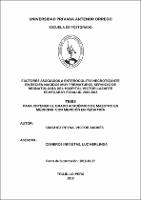Mostrar el registro sencillo del ítem
Factores asociados a enterocolitis necrotizante en recién nacidos muy prematuros, servicio de neonatología del Hospital Víctor Lazarte Echegaray EsSalud, 2013 - 2018
| dc.contributor.advisor | Cisneros Infantas, Luz Herlinda | |
| dc.contributor.author | Sánchez Reyna, Victor Andrés | |
| dc.creator | Sánchez Reyna, Victor Andrés | |
| dc.date.accessioned | 2019-11-07T15:38:27Z | |
| dc.date.available | 2019-11-07T15:38:27Z | |
| dc.date.issued | 2019 | |
| dc.identifier.uri | https://hdl.handle.net/20.500.12759/5609 | |
| dc.description.abstract | Introducción: La enterocolitis necrotizante es la emergencia abdominal quirúrgica más frecuente en los recién nacidos prematuros, con una tasa de mortalidad elevada. Existen factores asociados a ésta, como el uso de surfactante pulmonar, edad gestacional, peso al nacer, tipo de parto, administración de Citrato de Cafeína y Presión Positiva Continua en la Vía Área (CPAP) entre otros. Objetivos: Determinar los factores asociados a enterocolitis necrotizante en neonatos muy prematuros del Hospital Víctor Lazarte Echegaray durante los años 2013-2018. Materiales y métodos: Estudio observacional, analítico de casos y controles. Se revisaron 225 historias clínicas de neonatos bajo criterios de selección. En el análisis se utilizó regresión logística. Resultados: Los que tuvieron enterocolitis necrotizante (ENC) tuvieron de edad 29 semanas con RI: 28-32 y peso al nacer de 1524 gramos, con RI: 1205-1996 gramos. El 21.14%(n=26) de los que se usó el Surfactante Pulmonar tuvo ENC, y de la misma forma el 32.95%(n=57) y 33.51% (n=64) de los que tuvieron uso de Citrato de Cafeína y CPAP. Los que tuvieron parto por cesárea y por vía vaginal, el 32.97% (n=61) y 37.5% (n=15) tuvieron ENC. En el análisis bivariado, el Uso de surfactante fue significativo ( ORc: 0.43, IC:0.29-0.64 y p=0.0001. Conclusiones: De forma independiente, el uso de surfactante pulmonar fue el único factor asociado a ENC, siendo éste un factor protector. | es_PE |
| dc.description.abstract | Introduction: Necrotizing enterocolitis is the most frequent surgical emergency with a high mortality rate. There are factors associated with this, for example the use of Pulmonary Surfactant, age, birth weight, type of delivery, the administration of coffee citrate and continuous positive presion. Objectives: To determine the factors associated with necrotizing enterocolitis in moderate preterm neonates of the Lazarte Hospital 2013-2018. Materials and methods: Observational, analytical study of cases and controls. We reviewed 225 clinical histories of neonates under selection criteria. In the analysis, logistic regression was used. Results: Those who had necrotizing enterocolitis (ENC) had 29 weeks of age with RI: 28-32 and birth weight of 1524 with RI: 1205-1996. The 21.14% (n=26) of those who used the Pulmonary Surfactant had ENC, and in the same way 32.95% (n = 57) and 33.51% (n = 64) of those who had use of Caffeine Citrate and CPAP. For the type of delivery, from cesarean and vaginal way, 32.97% (n=61) and 37.5% (n=15) had ENC. In the bivariate analysis, the use of pulmonary surfactant was significant (ORc: 0.43, CI: 0.29-0.64, p=0.0001). Conclusions: Independently, only the use of surfactant was associated with ENC, being the use of surfactant a protective factor. | en_US |
| dc.description.uri | Tesis | es_PE |
| dc.format | application/pdf | es_PE |
| dc.language.iso | spa | es_PE |
| dc.publisher | Universidad Privada Antenor Orrego - UPAO | es_PE |
| dc.relation.ispartofseries | T_MAEST.MEDE_059 | |
| dc.rights | info:eu-repo/semantics/openAccess | es_PE |
| dc.source | Universidad Privada Antenor Orrego | es_PE |
| dc.source | Repositorio Institucional - UPAO | es_PE |
| dc.subject | Surfactante | es_PE |
| dc.subject | Enterocolitis | es_PE |
| dc.title | Factores asociados a enterocolitis necrotizante en recién nacidos muy prematuros, servicio de neonatología del Hospital Víctor Lazarte Echegaray EsSalud, 2013 - 2018 | es_PE |
| dc.type | info:eu-repo/semantics/masterThesis | es_PE |
| thesis.degree.level | Maestría | es_PE |
| thesis.degree.grantor | Universidad Privada Antenor Orrego. Escuela de Postgrado | es_PE |
| thesis.degree.name | Maestro en Medicina con Mención en Pediatría | es_PE |
| thesis.degree.discipline | Maestría en Medicina | es_PE |

